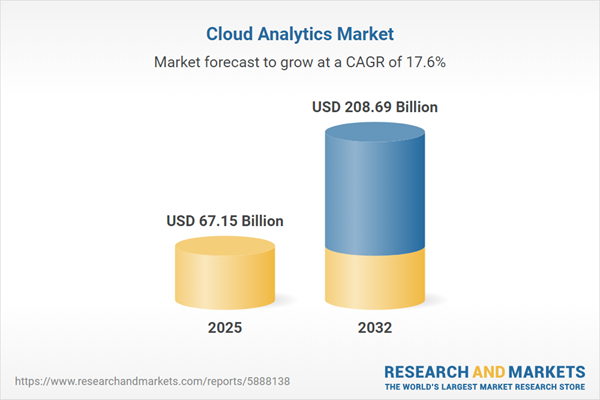Speak directly to the analyst to clarify any post sales queries you may have.
Cloud analytics is rapidly becoming central to digital transformation strategies, enabling senior decision-makers to advance data-driven operational excellence while navigating evolving market and regulatory pressures. As organizations prioritize agility and intelligent decision-making, cloud analytics emerges as a key enabler for competitive differentiation in a digital-first landscape.
Market Snapshot: Cloud Analytics Market Growth and Trends
The Cloud Analytics Market grew from USD 56.89 billion in 2024 to USD 67.15 billion in 2025. It is expected to continue growing at a CAGR of 17.63%, reaching USD 208.69 billion by 2032.
Scope & Segmentation of the Cloud Analytics Market
- Industry Verticals: BFSI (banking, capital markets, insurance), government (federal, state, local), healthcare (clinics, hospitals), IT and telecom (services, operators), manufacturing (discrete, process), retail (brick and mortar, e-commerce).
- Deployment Modes: Hybrid cloud, private cloud (hosted/private, on-premise), public cloud (IaaS, PaaS, SaaS).
- Organization Size: Large enterprises, small and medium enterprises.
- Component Types: Services (managed, professional), solution offerings (descriptive analytics, predictive analytics, prescriptive analytics).
- Business Functions: Finance and accounting (auditing, budgeting, compliance), human resources (payroll, recruitment), operations (logistics, supply chain), sales and marketing (campaign management, CRM, lead generation).
- Regional Coverage: Americas (North America, Latin America), Europe, Middle East & Africa, Asia-Pacific.
- Companies Analyzed: Amazon Web Services, Inc.; Microsoft Corporation; Google LLC; Alibaba Group Holding Limited; Tencent Holdings Limited; International Business Machines Corporation; Oracle Corporation; Salesforce, Inc.; SAP SE; Snowflake Inc.
Key Takeaways for Senior Decision-Makers
- Cloud analytics is critical for integrating real-time insights into business processes, empowering leaders to accelerate informed decision-making.
- The growing adoption of AI, edge computing, and containerization is streamlining data ingestion, processing, and advanced model deployment across industries.
- Sectors exhibit unique adoption patterns; for example, financial services focus on risk mitigation, while healthcare values outcome analytics and operational improvements.
- Hybrid and multi-cloud strategies are increasingly favored for balancing compliance demands with scalability and cost optimization.
- Vendor selection and architecture design now emphasize open-source frameworks and modularity to prevent lock-in and support long-term agility.
- Regional market nuances reinforce the necessity of localized compliance measures and tailored go-to-market approaches, particularly in evolving regulatory environments.
Tariff Impact on the Cloud Analytics Market
Recent US tariff changes have introduced complexities into global cloud analytics supply chains. Equipment manufacturers and hyperscale providers face elevated duties on key technology components, affecting procurement and pricing strategies. Organizations respond by diversifying suppliers, seeking tariff exemptions for essential products, and emphasizing open-source and modular platforms to maintain flexibility. Multinational enterprises are revisiting deployment roadmaps and long-term contracts, factoring in duty variances and risk mitigation measures to safeguard investments.
Cloud Analytics Market: Methodology & Data Sources
This analysis employs a multi-stage research methodology combining secondary research from industry publications and regulatory filings with primary interviews involving cloud architects, executives, and technology consultants. Data was triangulated by aligning survey responses with vendor disclosures and real-world case studies. Expert panels validated emerging use cases and assessed market implications to ensure accuracy and consistency across datasets.
Why This Report Matters
- Delivers strategic guidance on cloud analytics adoption, including regional best practices, segmentation trends, and vendor selection criteria relevant for digital transformation leaders.
- Provides actionable insights to optimize cost, performance, and compliance through tailored deployment strategies and evolving technology frameworks.
- Equips executives with validated, outcome-driven frameworks for reducing operational risk and enhancing enterprise resilience in a changing regulatory landscape.
Conclusion
Cloud analytics serves as a catalyst for enterprise innovation and operational optimization. By aligning technical architecture with business objectives and adapting to regulatory and market shifts, organizations can unlock sustained competitive advantage and future-ready transformation.
Additional Product Information:
- Purchase of this report includes 1 year online access with quarterly updates.
- This report can be updated on request. Please contact our Customer Experience team using the Ask a Question widget on our website.
Table of Contents
3. Executive Summary
4. Market Overview
7. Cumulative Impact of Artificial Intelligence 2025
Companies Mentioned
The companies profiled in this Cloud Analytics market report include:- Amazon Web Services, Inc.
- Microsoft Corporation
- Google LLC
- Alibaba Group Holding Limited
- Tencent Holdings Limited
- International Business Machines Corporation
- Oracle Corporation
- Salesforce, Inc.
- SAP SE
- Snowflake Inc.
Table Information
| Report Attribute | Details |
|---|---|
| No. of Pages | 189 |
| Published | November 2025 |
| Forecast Period | 2025 - 2032 |
| Estimated Market Value ( USD | $ 67.15 Billion |
| Forecasted Market Value ( USD | $ 208.69 Billion |
| Compound Annual Growth Rate | 17.6% |
| Regions Covered | Global |
| No. of Companies Mentioned | 11 |









